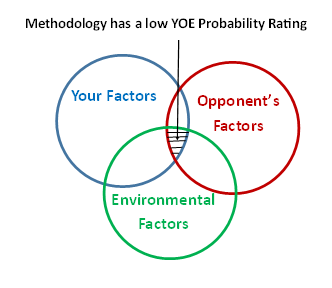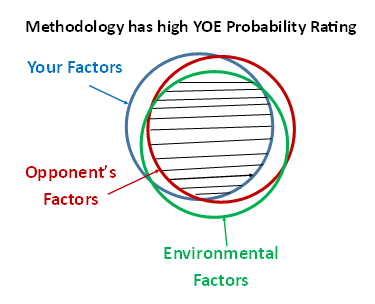Question: How many martial arts/self-defense experts does it take to change a light bulb?
Answer: Ten. One to screw it in and nine to say “that wouldn’t work on the street”.


One topic that is bound to get many martial artists/self-defense experts hot and bothered is the question of whether a particular self-protection technique/tactic/tool is or is not effective in the real world. What usually follows such a question is a litany of back and forth declarations, personal stories, anecdotes, insults and challenges based along tribal lines. What rarely happens is a discussion into the specific circumstances and factors involved that determine the outcome of the subject methodology.
The YOE Probability is an educational tool that is designed to change this situation.
The YOE Probability provides a rating and explaination analysis of a particular personal protection methodology (technique, tactic, tool). The rating is based on the probability of the subject methodology “working” as intended given three groupings of factors. These Groupings are: You, Your Opponent, and the Environment.
Each Grouping is made up of numerous factors (conditions) that must be taken into consideration in order to determine the estimated probability of the subject methodology working. A methodology that has a high probability of working means that:
- Most people are able to make it work
- against many types of opponents
- in various kinds of environments.
Whereas, a methodology that has a low probability of working means that:
- Few people are able to make it work
- against only select opponents
- in a minimal variety of environments.
Methodologies that have a high probability of working are those that have few factors required to make them work AND few factors that cause them to fail.
Methodologies that have a low probability of working are those that have numerous AND/OR select factors required to make them work AND/OR numerous factors that cause them to fail.
In order for you to make a methodology to work, there must be a positive intersection of the three Groupings. You must have the ability to execute it AND the methodology must work against your opponent AND it must work in the environment you both are in.
Therefore, a methodology that 90% of likely people can execute that works against 90% of likely opponents in 90% of likely environments has an overall probability of 73%.
Given that it is realistically not possible to place accurate numerical percentages on any of the three Groupings, the rating is a chosen number between 1-10 based on the assessment of the person doing the peer review. Where 1 represents very low probability and 10 represents very high probability of the methodology working as intended.
The intention of the YOE Probability is to provide concrete reasons as to what factors (conditions) determine whether or not a personal protection methodology “works” as it is intended. Given that the reviews are assessments based on the opinion of the Reviewer, the accuracy of the review depends upon the ability of the Reviewer to realistically determine the factors and conditions involved.
The rating given is not based on the Reviewer’s personal ability to execute the methodology, but on his or her ability to foresee the circumstances in which other people would have to execute the methodology.